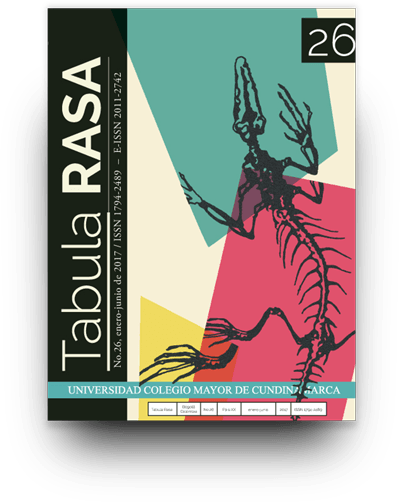Relational ontology and social cartography : towards an emancipating counter-mapping, or a counter-hegemonic delusion?
Ontología relacional y cartografía social : ¿hacia un contra-mapeo emancipador, o ilusión contra-hegemónica?
Show authors biography
Recent debates in assemblage thinking in the social sciences have stressed the notion of “relational ontologies” to conceptualize the complex interactions between humans and non-humans. In this article I examine the role of cartography in the politicization of relational ontologies, and in particular the potential of what has been termed “social cartography” in Colombia, which pretends to be a tool for challenging dominant cartographic representations. At the same time, I will reflect on the limits of this pretension and the ways in which social cartography has been coopted by dominant power.
Article visits 234 | PDF visits 127
Downloads
- Agnew, J. & Oslender, U. (2010). Territorialidades superpuestas, soberanía en disputa: lecciones empíricas desde América Latina, Tabula Rasa, 13,191-213.
- Agudelo, C. (2005). Retos del multiculturalismo en Colombia: política y poblaciones negras, Medellín: La Carreta Editores.
- Bell, M., Butlin, R.A. & Heffernan, M. (eds.). (1995). Geography and Imperialism, 1820-1940, Manchester: Manchester University Press.
- Blaser, M. (2010). Storytelling globalization from the Chaco and beyond, Durham: Duke University Press.
- Cairo, H. (2006). ‘Portugal is not a small country’: maps and propaganda in the Salazar Regime, Geopolitics 11, 367–395.
- Dalton, C. & Mason-Deese, L. (2012). Counter (mapping) actions: mapping as militant research, ACME 11(3), 439-466.
- Deleuze, G. & Guattari, F. (1987). A thousand plateaus: capitalism and schizophrenia (trans. Brian Massumi), Minneapolis, MN: University of Minnesota Press.
- Escobar, A. (2008). Territories of difference: place, movements, life, redes, Durham, NC: Duke University Press.
- Escobar, A. (2014). Sentipensar con la tierra: nuevas lecturas sobre desarrollo, territorio y diferencia, Medellín: Ediciones UNAULA.
- Freire, P. (1971). Pedagogy of the oppressed, New York: Herder and Herder.
- Galeano, E. (1998). Patas arriba: la escuela del mundo al revés, Montevideo: Ediciones del Chanchito.
- Godlewska, A. & Smith. (eds.). (1994). Geography and empire, Oxford: Blackwell.
- Hardt, M. & Negri, A. (2000). Empire, Cambridge, MA: Harvard University Press.
- Harley, J.B. (2001). The new nature of maps (Paul Laxton, ed.), Baltimore: Johns Hopkins University Press.
- Harley, J.B. & Woodward, D. (eds.) (1987). History of cartography, University of Chicago Press.
- Harris, L. & Hazen, H. (2005). Power of maps: (counter) mapping for conservation, ACME 4(1), 99-130.
- IGAC (Instituto Geográfico Agustín Codazzi). (1999). Paisajes vividos, paisajes observados : la percepción territorial en la zonificación ecológica del Pacífico colombiano, Bogotá: Editorial Gente Nueva.
- Massey, D. (2005). For space, London: Sage.
- Mignolo, W. (2005). The idea of Latin America, Oxford: Blackwell.
- Offen, K. (2009). O mapeas o te mapean: mapeo indígena y negro en América Latina, Tabula Rasa, 10, 163-189.
- Oslender, U. (2001). La lógica del río: estructuras espaciales del proceso organizativo de los movimientos sociales de comunidades negras en el Pacífico colombiano, en M. Pardo (ed), Acción colectiva, Estado y etnicidad en el Pacífico colombiano, pp. 123-148. Bogotá: ICANH-Colciencias.
- Oslender, U. (2011). Comunidades negras y espacio en el Pacífico colombiano: hacia un giro geográfico en el estudio de los movimientos sociales, Bogotá: Instituto Colombiano de Antropología e Historia.
- Peluso, N.L. (1995). Whose woods are these?: counter-mapping forest territories in Kalimantan, Indonesia, Antipode 27(4), 383-406.
- Restrepo, E. (2013). Etnización de la negridad: la invención de las «comunidades negras» como grupo étnico en Colombia, Popayán: Universidad del Cauca.
- Said, E. (2003). Orientalism, London: Penguin Books.
- Snyder, J. (1993). Flattening the earth: two thousand years of map projections, Chicago: The University of Chicago Press.
- Vargas, P. (1999). Propuesta metodológica para la investigación participativa de la percepción territorial en el Pacífico, en J. Camacho & E. Restrepo (eds), De montes, ríos y ciudades: territorios e identidades de la gente negra en Colombia, pp. 143-176. Bogotá: Ecofondo/ICAN/Fundación Natura.
- Wood, D. (2010). Rethinking the power of maps, New York: Guilford Press.
- Wood, D. & Fels, J. (1992). The power of maps, New York: Guilford Press.




